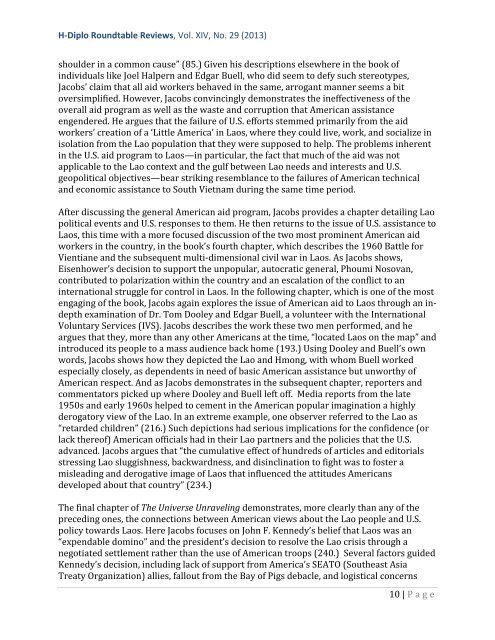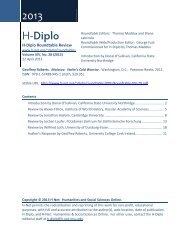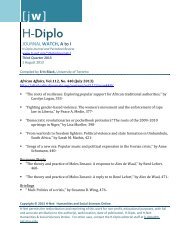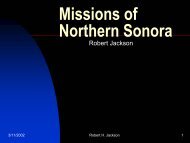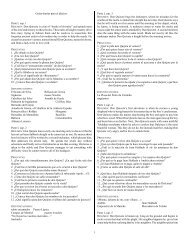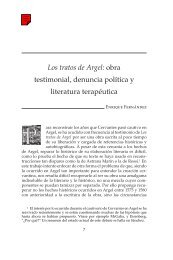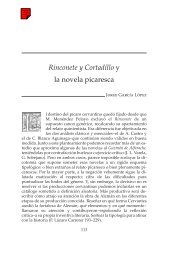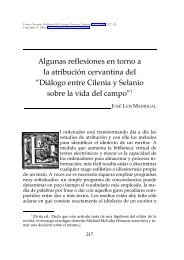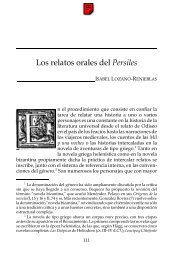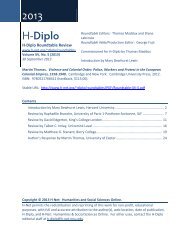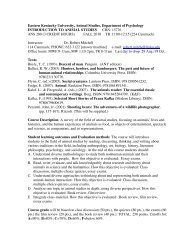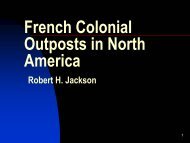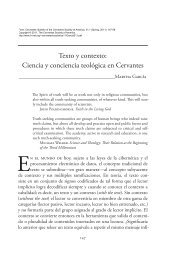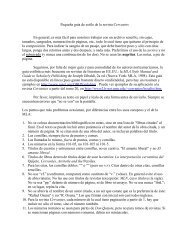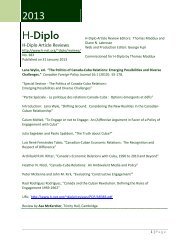H-Diplo Roundtables, Vol. XIV, No. 29 (2013) - H-Net
H-Diplo Roundtables, Vol. XIV, No. 29 (2013) - H-Net
H-Diplo Roundtables, Vol. XIV, No. 29 (2013) - H-Net
You also want an ePaper? Increase the reach of your titles
YUMPU automatically turns print PDFs into web optimized ePapers that Google loves.
H-<strong>Diplo</strong> Roundtable Reviews, <strong>Vol</strong>. <strong>XIV</strong>, <strong>No</strong>. <strong>29</strong> (<strong>2013</strong>)<br />
shoulder in a common cause” (85.) Given his descriptions elsewhere in the book of<br />
individuals like Joel Halpern and Edgar Buell, who did seem to defy such stereotypes,<br />
Jacobs’ claim that all aid workers behaved in the same, arrogant manner seems a bit<br />
oversimplified. However, Jacobs convincingly demonstrates the ineffectiveness of the<br />
overall aid program as well as the waste and corruption that American assistance<br />
engendered. He argues that the failure of U.S. efforts stemmed primarily from the aid<br />
workers’ creation of a ‘Little America’ in Laos, where they could live, work, and socialize in<br />
isolation from the Lao population that they were supposed to help. The problems inherent<br />
in the U.S. aid program to Laos—in particular, the fact that much of the aid was not<br />
applicable to the Lao context and the gulf between Lao needs and interests and U.S.<br />
geopolitical objectives—bear striking resemblance to the failures of American technical<br />
and economic assistance to South Vietnam during the same time period.<br />
After discussing the general American aid program, Jacobs provides a chapter detailing Lao<br />
political events and U.S. responses to them. He then returns to the issue of U.S. assistance to<br />
Laos, this time with a more focused discussion of the two most prominent American aid<br />
workers in the country, in the book’s fourth chapter, which describes the 1960 Battle for<br />
Vientiane and the subsequent multi-dimensional civil war in Laos. As Jacobs shows,<br />
Eisenhower’s decision to support the unpopular, autocratic general, Phoumi <strong>No</strong>sovan,<br />
contributed to polarization within the country and an escalation of the conflict to an<br />
international struggle for control in Laos. In the following chapter, which is one of the most<br />
engaging of the book, Jacobs again explores the issue of American aid to Laos through an indepth<br />
examination of Dr. Tom Dooley and Edgar Buell, a volunteer with the International<br />
<strong>Vol</strong>untary Services (IVS). Jacobs describes the work these two men performed, and he<br />
argues that they, more than any other Americans at the time, “located Laos on the map” and<br />
introduced its people to a mass audience back home (193.) Using Dooley and Buell’s own<br />
words, Jacobs shows how they depicted the Lao and Hmong, with whom Buell worked<br />
especially closely, as dependents in need of basic American assistance but unworthy of<br />
American respect. And as Jacobs demonstrates in the subsequent chapter, reporters and<br />
commentators picked up where Dooley and Buell left off. Media reports from the late<br />
1950s and early 1960s helped to cement in the American popular imagination a highly<br />
derogatory view of the Lao. In an extreme example, one observer referred to the Lao as<br />
“retarded children” (216.) Such depictions had serious implications for the confidence (or<br />
lack thereof) American officials had in their Lao partners and the policies that the U.S.<br />
advanced. Jacobs argues that “the cumulative effect of hundreds of articles and editorials<br />
stressing Lao sluggishness, backwardness, and disinclination to fight was to foster a<br />
misleading and derogative image of Laos that influenced the attitudes Americans<br />
developed about that country” (234.)<br />
The final chapter of The Universe Unraveling demonstrates, more clearly than any of the<br />
preceding ones, the connections between American views about the Lao people and U.S.<br />
policy towards Laos. Here Jacobs focuses on John F. Kennedy’s belief that Laos was an<br />
“expendable domino” and the president’s decision to resolve the Lao crisis through a<br />
negotiated settlement rather than the use of American troops (240.) Several factors guided<br />
Kennedy’s decision, including lack of support from America’s SEATO (Southeast Asia<br />
Treaty Organization) allies, fallout from the Bay of Pigs debacle, and logistical concerns<br />
10 | P age


